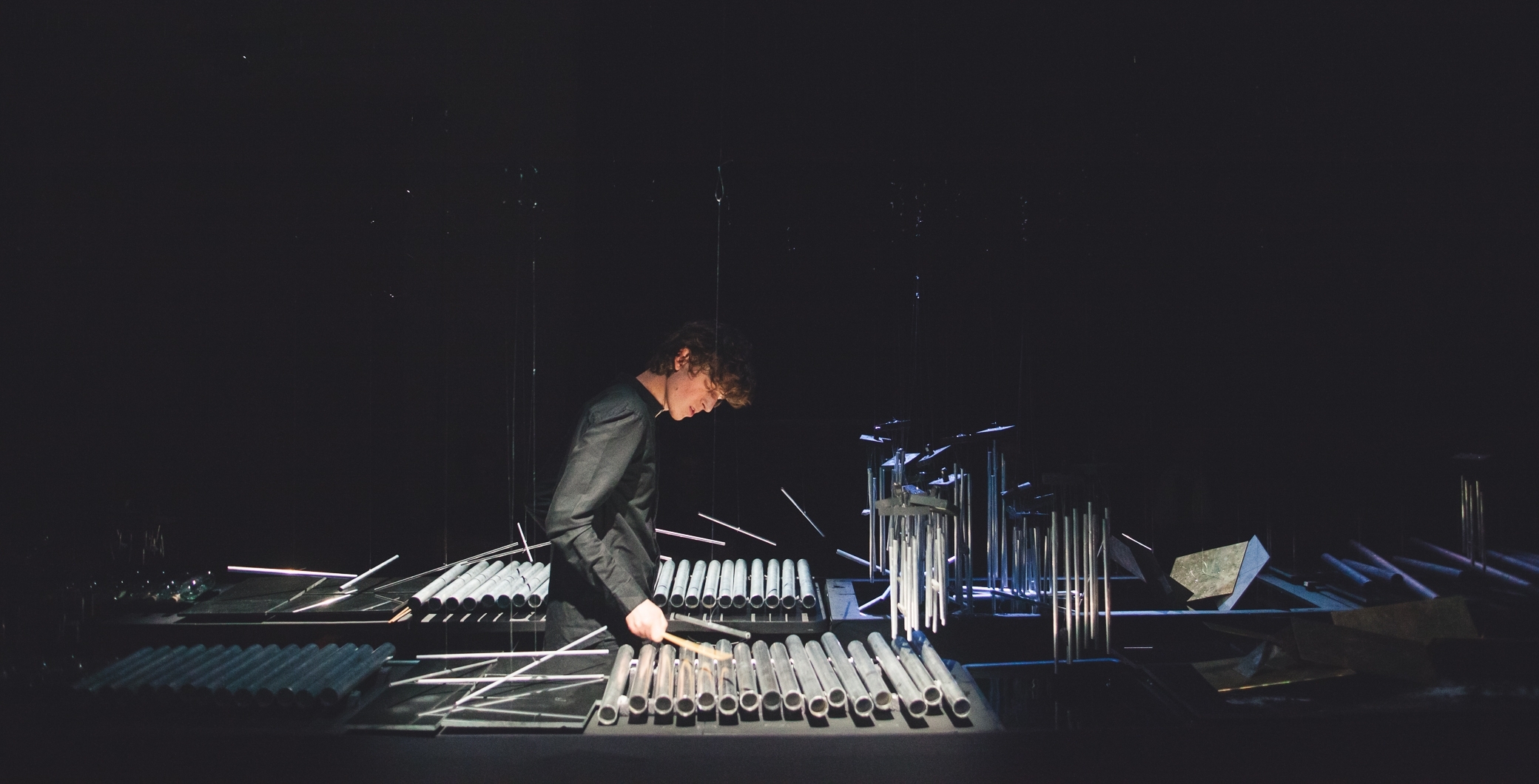Although Fluvial is described as being a performance of one soloist engaging with one large-scale kinetic percussive instrument, the sounds are actually created by 100 different objects forming one percussive whole. “Some are glass bottles; there are aluminium tubes, brass plates,” continues its creator. “The metal objects hover above 1.5 metre pools of water and their pitch is changed as they dip into the water. The aluminium tubes hover above a bed of granite. There are 2.8 metre lines of granite tiling on the table. Black granite is a beautiful stone; it’s the hardest form of stone you can buy. It’s so dense and hard, so it has the most resonant clear ringing pitch, and when you’re cutting each tile there are tiny flaws in design, giving each tile a unique pitch.”
Schack-Arnott works is obviously as inspired by image as much as sound. “I am a visual person; I’m also an improviser, I’ve trained in classical notated performance, I have a background in orchestra but I get inspiration from improvisation practice. I’m always writing while developing my work. I hone my own thoughts, and I’m recording ideas, listening back and refining, so it’s using a lot of different processes, different concepts bubble to the surface. It’s a mix of a lot of different processes.”
Audiences coming along to Fluvial are in for astonishing imagery along with aural surprises. Just walking into the space is a dramatic experience to begin with. “I worked with a lighting designer and an art technician in construction of the instruments.” The visual effect is very dynamic. It creates a kind of world unto itself,” says Schack-Arnott. “When people enter the space they walk into an environment where the instruments are so big – there is a quite vast horizon of glistening metal. The idea created in their minds when they see it leads to a very different type of expectation than they would have for a typical musical performance. The objects have a musical life of their own, the movement of the instrument is a source of sound, and the poetic tension of that is interesting to me.”
Does he play the whole thing himself? “I am a soloist but I exist as a conduit for this natural form, rather than the traditional idea of a soloist; I gradually traverse the length of the instruments in a 40-minute piece and express some ideas. That is the heart of what I’m trying to do.”
Does he have a special moment in the work he enjoys the most? “I made 30 micro-tunnel wind chimes that hover above the instruments, at their tops there are nuanced little springs, the audience can’t see them but when they’re touched the wind chimes hover and bounce – they move along the axis with a jellyfish quality to their movements.”
Schack-Arnott has customised the wind chimes to produce his unusual sounds. “The wind chimes are aluminium tubes and I adjust their pitch. Most wind chimes you buy are tuned to a pentatonic scale. These ones I made myself to a tight microtonal cluster. You can change a target to control the pitch – Any change in a variable will alter the pitch: thickness, diameter, length, by changing the length of the tube, for example; there’s an algorithm online you can use to help you decide what length to cut them to, it’s quite specific. I cut the tubes to create a whole scale so that instead of a 12 note octave you have a 70 note octave, which creates an extremely nuanced pitch change, almost imperceptible to the ear, and together these create a pitch cluster which is not what you normally hear.”
Matthias Schack-Arnott is chuffed that people ‘get’ it. “I’ve just won a Green Room award. It’s a nice way to achieve that kind of recognition. I’ve been doing strange projects for a long time. You have those perplexing moments – ‘what does it mean? Why is it here?’ You have this strange idea in your head for a so long – you’ve been working alone for half a year by the time it actually comes to performance. And audiences have totally come on the journey with me, it’s amazing. I make strange unusual things and people have been enchanted, visibly moved, and intrigued; I’ve had an amazing response.”
BY LIZA DEZFOULI







